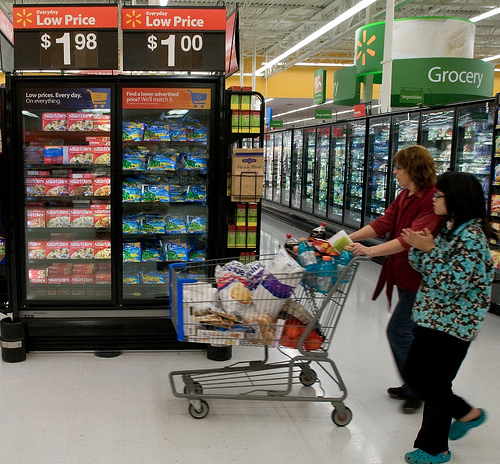
Yes it's cheap but ... (Photo by Walmart Stores.)
Aubretia Edick has worked at a Walmart store in upstate New York for 11 years, but she won’t buy fresh food there. Bagged salads, she claims, are often past their sell-by dates and, in the summer, fruit is sometimes kept on shelves until it rots. “They say, ‘We’ll take care of it,’ but they don’t. As a cashier, you hear a lot of people complain,” she said.
Edick blames the problems on the store’s chronic understaffing and Walmart’s lack of respect for the skilled labor needed to handle the nation’s food supply. At her store, a former maintenance person was made produce manager. He’s often diverted to other tasks. “If the toilets get backed up, they call him,” she said.
Tracie McMillan, who did a stint working in the produce section of a Walmart store while researching her forthcoming book, The American Way of Eating, reports much the same. “They put a 20-year-old from electronics in charge of the produce department. He didn’t know anything about food,” she said. “We had a leak in the cooler that didn’t get fixed for a month and all this moldy food was going out on the floor.” Walmart doesn’t accept the idea that “a supermarket takes any skill to run,” she said. “They treated the produce like any other kind of merchandise.”
That’s plenty to give a shopper pause, but it’s just the tip of the iceberg when it comes to reasons to be concerned about Walmart’s explosive expansion into the grocery sector.
Growth of a giant
In just a few short years, Walmart has become the most powerful force in our food system, more dominant than Monsanto, Kraft, or Tyson.
It was only 23 years ago that Walmart opened its first supercenter, a store with a full supermarket inside. By 1998, it was still a relatively modest player with 441 supercenters and about 6 percent of U.S. grocery sales. Last year, as its supercenter count climbed above 3,000, Walmart captured 25 percent of the $550 billion Americans spent on groceries.
As astonishing as Walmart’s national market share is, in many parts of the country the chain is even more dominant. In 29 metro markets, it accounts for more than 50 percent of grocery sales.
Seeking an even bigger piece of the pie, Walmart is campaigning to blanket New York, Chicago, Washington, D.C., and other big cities with its stores. It has made food the centerpiece of its public relations strategy. In a series of announcements over the last year, Walmart has deftly commandeered high-profile food issues, presenting itself as a solution to food deserts, a force for healthier eating, and a supporter of local farming.
It is a remarkably brazen tactic. On every one of these fronts, Walmart is very much part of the problem. Its expansion is making our food system more concentrated and industrialized than ever before. Its growth in cities will likely exacerbate poverty, the root cause of constrained choices and poor diet. And the more dominant Walmart becomes, the fewer opportunities there will be for farmers markets, food co-ops, neighborhood grocery stores, and a host of other enterprises that are beginning to fashion a better food system — one organized not to enrich corporate middlemen, but to the benefit of producers and eaters.
The big squeeze
Walmart’s rise as a grocer triggered two massive waves of industry consolidation in the late 1990s and early 2000s. One occurred among supermarkets, as regional titans like Kroger and Fred Meyer combined to form national chains that stood a better chance of surviving Walmart’s push into groceries. Today, the top five food retailers capture half of all grocery sales, double the share they held in 1997.
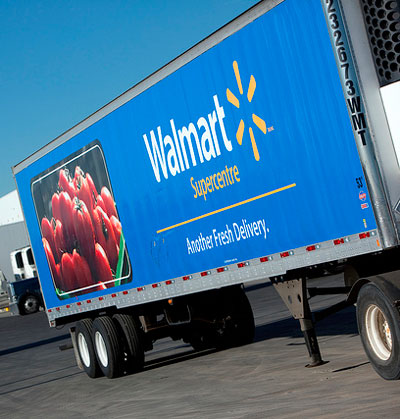
Go big or go out of business. (Photo by Walmart Stores.)
The second wave of consolidation came as meatpackers, dairy companies, and other food processors merged in an effort to be large enough to supply Walmart without getting crushed in the process. The takeover of IBP, the nation’s largest beef processor, by Tyson Fresh Meats is a prime example. “When Tyson bought IBP in 2001, they said they had to do that in order to supply Walmart. We saw horizontal integration in the meat business because of worries about access to the retail market,” explained Mary Hendrickson, a food systems expert at the University of Missouri. Four firms now slaughter more than 80 percent of cattle. A similar dynamic has played out in nearly every segment of food manufacturing.
“The consolidation of the last two decades has created a food chain that’s shaped like an hourglass,” noted Wenonah Hauter, executive director of Food & Water Watch, explaining that a handful of middlemen now stand between 2 million farmers and 300 million eaters.
Their tight grip on our food supply has, rather predictably, come at the expense of both ends of the hourglass. Grocery prices have been rising faster than inflation and, while there are multiple factors driving up consumer costs, some economic research points to concentration in both food manufacturing and retailing as a leading culprit.
Farmers, meanwhile, are getting paid less and less. Take pork, for example. Between 1990 and 2009, the farmers’ share of each dollar consumers spent on pork fell from 45 to 25 cents, according to the USDA Economic Research Service. Pork processors picked up some of the difference, but the bulk of the gains went to Walmart and other supermarket chains, which are now pocketing 61 cents of each pork dollar, up from 45 cents in 1990.
Another USDA analysis found that big retailers have used their market power to shortchange farmers who grow apples, lettuce, and other types of produce, paying them less than what they would get in a competitive market, while also charging consumers inflated prices. In this way, Walmart has actually helped drive overall food prices up.
What Walmart means when it says “local”
Last year, Walmart announced that it would double the share of local produce it sells, from 4.5 to 9 percent, over six years.
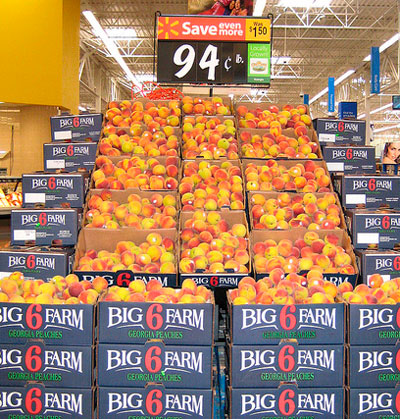
Come and get your Georgia peaches. (Photo by Walmart Stores.)
This doesn’t necessarily mean shoppers will soon find a variety of local produce at their nearest Walmart, however. Walmart counts fruits and vegetables as local if they come from within the same state. It can achieve much of its promise by buying more of each state’s major commodity crops, such as peaches in Georgia and apples in Washington, and by using big states like California, Texas, and Florida, where both supercenters and large-scale farming are prevalent, to pump up its national average.
“It speaks to the weakness that we’ve all known about, which is that ‘local’ is an inadequate descriptor of what we want,” said Andy Fisher, former executive director of the Community Food Security Coalition. “It’s not just geography; it’s scale and ownership and how you treat your workers. Walmart is doing industrial local.”
Walmart’s sourcing is becoming somewhat more regional, but the change has more to do with rising diesel prices than a shift in favor of small farms. It’s a sign that Walmart’s Achilles heel — the fossil-fuel intensity of its far-flung distribution system — might be catching up with it. According to The Wall Street Journal, trucking produce like jalapeños across the country from California or Mexico has become so expensive that the retailer is now seeking growers within 450 miles of its distribution centers.
“They see the writing on the wall. They know the cost of shipping from California back to Georgia and Mississippi is high now,” said Ben Burkett, a Mississippi farmer who noted that Walmart is now meeting with producers in his region. He’s hoping to sell the chain okra through a cooperative of 35 farmers. “We’ll see. My experience in the past with Walmart is they want to pay as little as possible.”
That skepticism is shared by Anthony Flaccavento, a Virginia farmer and sustainable food advocate. “If multimillion-dollar companies like Rubbermaid and Vlasic can be brought to their knees by the retail behemoth, how should we expect small farmers to fare?” he asks.
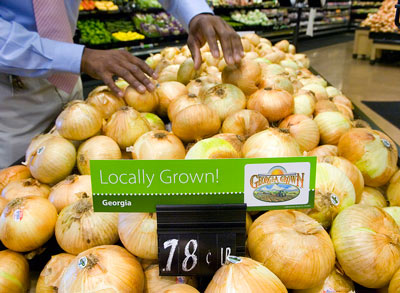
Local is the new organic — and Walmart does both the corporate, industrial way. (Photo by Walmart Stores.)
Walmart’s promise to increase local sourcing is reminiscent of its pledge five years ago to expand its organic food offerings. “They held true to their corporate model and tried to do organics the same way,” said Mark Kastel of the Cornucopia Institute. For its store-brand organic milk, for example, Walmart turned to Aurora Organic Dairy, which runs several giant industrial milking operations in Texas and Colorado, each with as many as 10,000 cows. In 2007, the USDA sanctioned Aurora for multiple violations of organic standards. Earlier this year, the agency stepped in again, this time revoking the organic certification for Promiseland Livestock, which had been supplying supposedly organically raised cows to Aurora.
These days, Walmart’s interest in organic food seems to have ebbed. “Our observation is that they sell fewer organic products and produce now than four years ago,” said Kastel. Ronnie Cummins of the Organic Consumers Association agrees. Today, he says, “the proportion of their sales that is organic is the lowest of any major supermarket chain.”
Leveraging food deserts
Walmart has renewed its push to get into big cities, after trying and failing a few years ago. This time the company has honed a fresh strategy that goes right to the soft underbelly of urban concerns. In July, Walmart officials, standing alongside First Lady Michelle Obama, pledged to open or expand as many as 300 stores “in or near” food deserts.
Walmart sees underserved neighborhoods as a way to edge its camel’s nose under the tent and then do what it’s done in the rest of the country: open dozens of stores situated to take market share from local grocers and unionized supermarkets. Stephen Colbert dubbed the strategy Walmart’s “Trojan cantaloupe.” For example, an analysis by Manhattan Borough President Scott Stringer’s office estimates that if Walmart opens in Harlem, at least 30 supermarkets, green grocers, and bodegas selling fresh produce would close.
For neighborhoods that are truly underserved, it seems hard to argue with the notion that having a Walmart nearby is better than relying on 7-11 and McDonald’s for meals. But poor diet, limited access to fresh food, and diet-related health issues are a cluster of symptoms that all stem from a deeper problem that Walmart is likely to make worse: poverty. Poverty has a strong negative effect on diet quality, a 15-year study recently concluded, and access to a supermarket makes almost no difference.
Neighborhoods that gain Walmart stores end up with more poverty and food-stamp usage than communities where the retailer does not open, a study published in Social Science Quarterly found. This increase in poverty may owe to the fact that Walmart’s arrival leads to a net loss of jobs and lowers wages, according to research [PDF] by economists at the University of California-Irvine and Cornell.
Walmart has also been linked to rising obesity. “An additional supercenter per 100,000 residents increases … the obesity rate by 2.3 percentage points,” a recent study concluded. “These results imply that the proliferation of Walmart supercenters explains 10.5 percent of the rise in obesity since the late 1980s.”
The bottom line for poor families is that processed food is cheaper than fresh vegetables — and that’s especially true if you shop at Walmart. The retailer beats its competitors on prices for packaged foods, but not produce. An Iowa study found that Walmart charges less than competing grocery stores for cereals, canned vegetables, and meats, but has higher prices on most fresh vegetables and high-volume dairy foods, including milk.
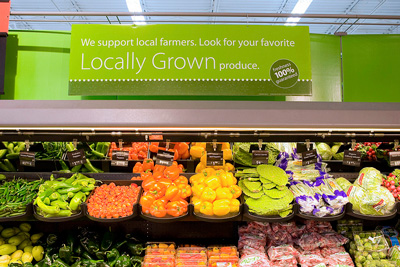
Local? I don't think that word means what you think it means. (Photo by Walmart Stores.)
The future of food?
We stand to lose a lot if Walmart keeps tightening its grip on the grocery sector. Signs of a revitalized food system have been springing up all over — farmers markets, urban gardeners, neighborhood grocers, consumer co-ops, CSAs — but their growth may well be cut short if Walmart has its way.
“People need to keep an eye on the values that are at the root of what is driving so much of this activity around the food system,” said Kathy Mulvey, policy director for the Community Food Security Coalition.
Walmart is pushing us toward a future where food production is increasingly industrialized, farmers and workers are squeezed, and the promise of fresh produce is used to conceal an economic model that leaves neighborhoods more impoverished. Are we going to let it happen, or are we going to demand better food and a better world?

